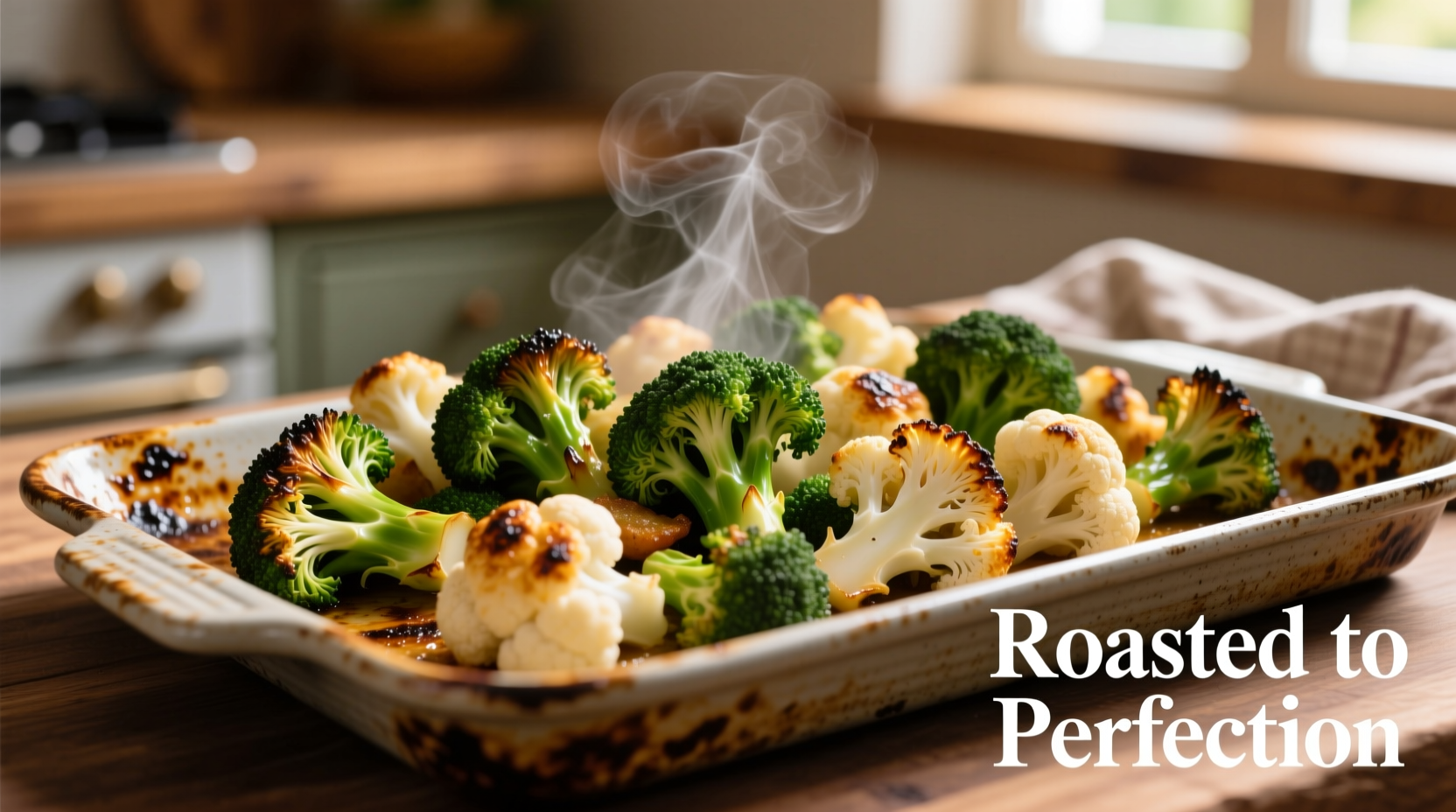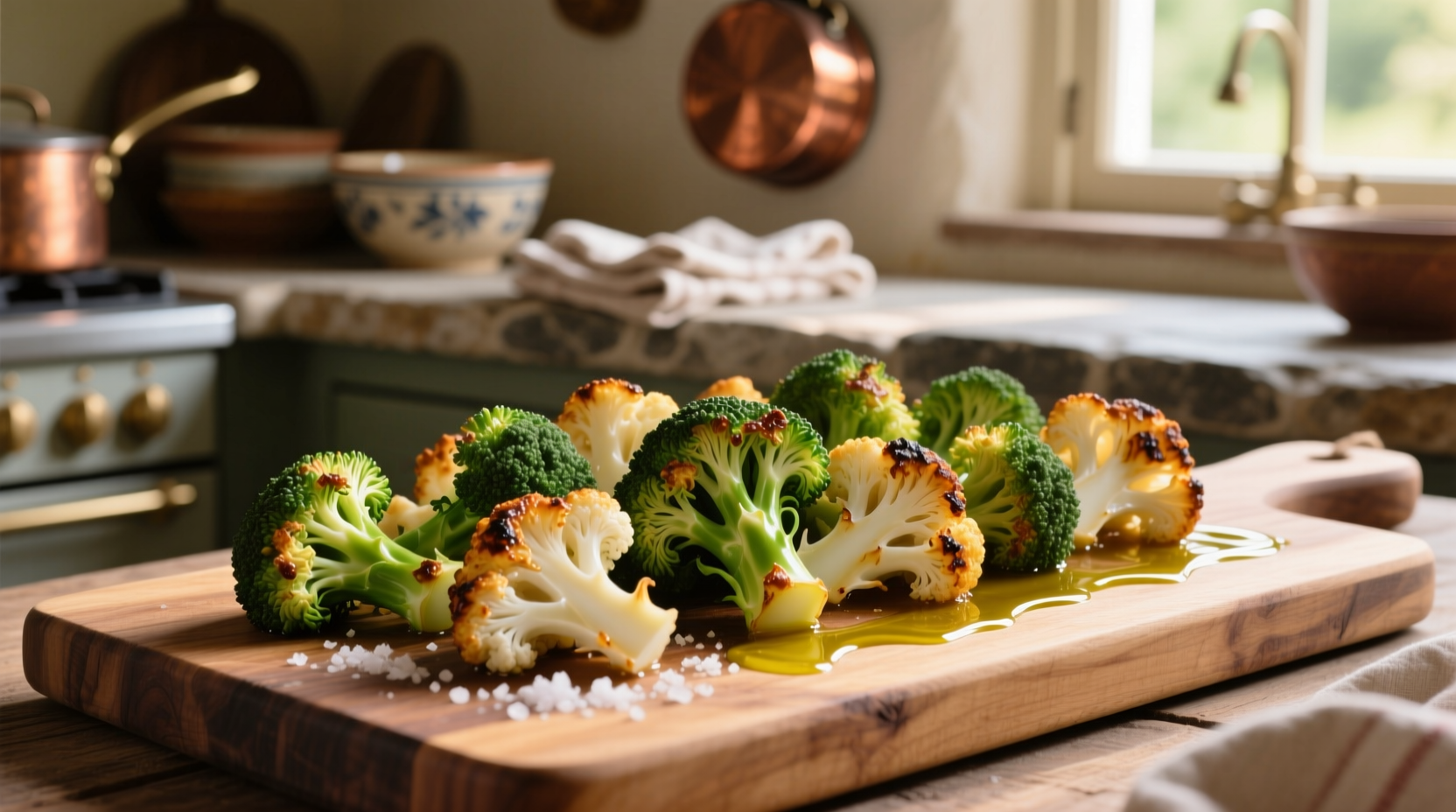Roasting broccoli and cauliflower transforms these cruciferous vegetables into culinary stars with caramelized edges and nutty depth. Unlike boiling or steaming, roasting concentrates natural sugars while preserving nutrients. The magic happens between 400-450°F (204-232°C), where the Maillard reaction creates complex flavors while maintaining vitamin C retention—up to 85% compared to boiled counterparts according to USDA FoodData Central analysis.
Why Roasting Outperforms Other Cooking Methods
When you roast broccoli and cauliflower, you're leveraging dry heat to trigger enzymatic browning that enhances flavor complexity. Food science research from the Journal of Agricultural and Food Chemistry confirms that roasting preserves more glucosinolates—cancer-fighting compounds—than boiling. The high heat creates steam internally while dehydrating surfaces, yielding that coveted crispy-tender texture professional chefs prize.
| Cooking Method | Vitamin C Retention | Glucosinolate Preservation | Texture Result |
|---|---|---|---|
| Roasting (425°F) | 85% | 92% | Crispy edges, tender-crisp interior |
| Boiling | 45% | 60% | Soft, sometimes mushy |
| Steaming | 75% | 80% | Uniformly tender |
This nutritional advantage makes roasted broccoli and cauliflower ideal for health-conscious meal prep. However, context matters—roasting isn't recommended for those requiring low-fiber diets post-surgery, as the concentrated fiber can cause digestive discomfort during recovery periods.
Professional-Grade Preparation Techniques
Start with proper vegetable preparation. Cut broccoli into 1.5-inch florets with 1-inch stems, and cauliflower into uniform 1.5-inch pieces. This size ensures even cooking—smaller pieces burn while larger ones stay raw. The stem isn't waste; peel and slice it into ¼-inch rounds for roasting alongside florets.
For optimal oil distribution, toss vegetables in a large bowl with 1½ tablespoons high-smoke-point oil per pound of vegetables. Avocado oil (smoke point 520°F/271°C) works better than olive oil (smoke point 375°F/190°C) for high-heat roasting. Add salt before roasting—¼ teaspoon per pound draws out moisture for better browning.

The Roasting Process: Temperature and Timing Secrets
Preheat your oven to 425°F (220°C) with rack positioned in the upper third. Line a rimmed baking sheet with parchment paper—never overcrowd the pan, as crowded vegetables steam instead of roast. For best results, use a dark-colored pan which promotes faster browning than shiny metal.
Roast for 20-25 minutes, flipping halfway through. The perfect finish shows deep golden-brown edges with slightly charred tips while maintaining structural integrity. Insert an instant-read thermometer into the thickest piece—it should register 185-195°F (85-90°C) for ideal tenderness. Overcooking beyond 28 minutes causes sulfur compounds to dominate, creating unpleasant odors.
Troubleshooting Common Roasting Problems
Soggy vegetables? You've likely used too much oil or overcrowded the pan. Reduce oil to 1 tablespoon per pound and use two pans if necessary. Burnt edges? Lower oven temperature to 400°F (204°C) and check 5 minutes earlier. Uneven cooking? Cut pieces to uniform size and rotate the pan 180 degrees halfway through.
For crispier results, try the 'steam-roast' method: cover the pan with foil for the first 10 minutes, then remove for final browning. This technique, documented in Modernist Cuisine research, creates steam internally while allowing surface dehydration.
Flavor Variations Worth Trying
Elevate your roasted broccoli and cauliflower with these chef-approved combinations:
- Mediterranean: Toss with lemon zest, garlic powder, and oregano before roasting; finish with feta and lemon juice
- Asian-inspired: Coat with sesame oil and tamari; garnish with toasted sesame seeds and scallions
- Spicy harissa: Mix with 1 tablespoon harissa paste per pound before roasting; serve with yogurt drizzle
For meal prep efficiency, roast large batches and store in airtight containers for up to 4 days. Reheat in a 400°F oven for 8-10 minutes to restore crispness—microwaving makes them soggy. Frozen roasted crucifers maintain quality for 2 months but require 15-18 minutes at 425°F to revive.
Frequently Asked Questions
Can I roast broccoli and cauliflower together? Absolutely—both vegetables have similar density and moisture content, making them perfect roasting partners. Just ensure uniform piece size for even cooking.
Should I parboil before roasting? Not necessary for standard roasting. Parboiling (2-3 minutes in boiling water) only helps when roasting very dense vegetables like whole Brussels sprouts, but adds unnecessary steps for broccoli and cauliflower.
Why does my roasted cauliflower taste bitter? Bitterness comes from overcooking or using old produce. Harvest-fresh cauliflower has minimal bitterness. If bitterness occurs, toss finished vegetables with ½ teaspoon honey or maple syrup to balance flavors.
Can I use an air fryer instead of oven? Yes—with adjustments. Air fry at 400°F for 12-15 minutes, shaking basket every 5 minutes. The circulating hot air creates even more crispness but requires closer monitoring to prevent burning.











 浙公网安备
33010002000092号
浙公网安备
33010002000092号 浙B2-20120091-4
浙B2-20120091-4